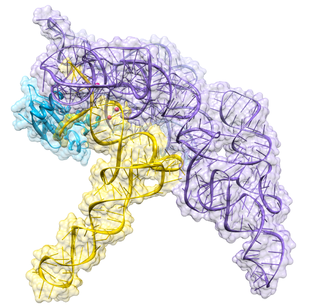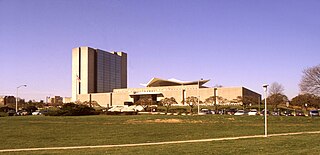In molecular biology, housekeeping genes are typically constitutive genes that are required for the maintenance of basic cellular function, and are expressed in all cells of an organism under normal and patho-physiological conditions. Although some housekeeping genes are expressed at relatively constant rates in most non-pathological situations, the expression of other housekeeping genes may vary depending on experimental conditions.

Ribonuclease P is a type of ribonuclease which cleaves RNA. RNase P is unique from other RNases in that it is a ribozyme – a ribonucleic acid that acts as a catalyst in the same way that a protein-based enzyme would. Its function is to cleave off an extra, or precursor, sequence of RNA on tRNA molecules. Further, RNase P is one of two known multiple turnover ribozymes in nature, the discovery of which earned Sidney Altman and Thomas Cech the Nobel Prize in Chemistry in 1989: in the 1970s, Altman discovered the existence of precursor tRNA with flanking sequences and was the first to characterize RNase P and its activity in processing of the 5' leader sequence of precursor tRNA. Recent findings also reveal that RNase P has a new function. It has been shown that human nuclear RNase P is required for the normal and efficient transcription of various small noncoding RNAs, such as tRNA, 5S rRNA, SRP RNA and U6 snRNA genes, which are transcribed by RNA polymerase III, one of three major nuclear RNA polymerases in human cells.

PTEN-induced kinase 1 (PINK1) is a mitochondrial serine/threonine-protein kinase encoded by the PINK1 gene.

DnaJ homolog subfamily A member 3, mitochondrial, also known as Tumorous imaginal disc 1 (TID1), is a protein that in humans is encoded by the DNAJA3 gene on chromosome 16. This protein belongs to the DNAJ/Hsp40 protein family, which is known for binding and activating Hsp70 chaperone proteins to perform protein folding, degradation, and complex assembly. As a mitochondrial protein, it is involved in maintaining membrane potential and mitochondrial DNA (mtDNA) integrity, as well as cellular processes such as cell movement, growth, and death. Furthermore, it is associated with a broad range of diseases, including neurodegenerative diseases, inflammatory diseases, and cancers.
In enzymology, a Fas-activated serine/threonine kinase is an enzyme that catalyzes the chemical reaction

39S ribosomal protein L12, mitochondrial is a protein that in humans is encoded by the MRPL12 gene.

Transforming growth factor beta regulator 4 (TBRG4), also known as cell cycle progression restoration protein 2 (CPR2) and FAST kinase domain-containing protein 4 (FASTKD4), is a protein that in humans is encoded by the TBRG4 gene on chromosome 7. This protein is part of the FASTKD family, which is known for regulating the energy balance of mitochondria under stress and cell cycle progression. TBRG4 is involved in cell proliferation in hematopoiesis and multiple myeloma.

39S ribosomal protein L19, mitochondrial is a protein that in humans is encoded by the MRPL19 gene.

PKN3 is a protein kinase C-related molecule and thought to be an effector mediating malignant cell growth downstream of activated phosphoinositide 3-kinase (PI3K). It is thought that chronic activation of the phosphoinositide 3-kinase (PI3K)/PTEN signal transduction pathway contributes to metastatic cell growth and that PKN3 may mediate that growth.1

39S ribosomal protein L37, mitochondrial is a protein that in humans is encoded by the MRPL37 gene.

28S ribosomal protein S33, mitochondrial is a protein that in humans is encoded by the MRPS33 gene.

28S ribosomal protein S25, mitochondrial is a protein that in humans is encoded by the MRPS25 gene.

28S ribosomal protein S5, mitochondrial is a protein that in humans is encoded by the MRPS5 gene.
Mitochondrial biogenesis is the process by which cells increase mitochondrial mass. It was first described by John Holloszy in the 1960s, when it was discovered that physical endurance training induced higher mitochondrial content levels, leading to greater glucose uptake by muscles. Mitochondrial biogenesis is activated by numerous different signals during times of cellular stress or in response to environmental stimuli, such as aerobic exercise.

FAST kinase domain-containing protein 1 is a protein that in humans is encoded by the FASTKD1 gene on chromosome 2. This protein is part of the FASTKD family, which is known for regulating the energy balance of mitochondria under stress. FASTKD1 is also an RNA-binding protein and has been associated with endometrial cancer.

FAST kinase domain-containing protein 5 (FASTKD5) is a protein that in humans is encoded by the FASTKD5 gene on chromosome 20. This protein is part of the FASTKD family, which is known for regulating the energy balance of mitochondria under stress. FASTKD5 is also required for RNA granules to process precursor mRNAs not flanked by tRNAs.

Pyrroline-5-carboxylate reductase family, member 2 is a protein that in humans is encoded by the PYCR2 gene.

Mitochondrial ribosome or mitoribosome is a protein complex that is active in mitochondria and functions as a riboprotein for translating mitochondrial mRNAs encoded in mtDNA. Mitoribosomes, like cytoplasmic ribosomes, consist of two subunits — large (mtLSU) and small (mt-SSU). However, the ratio of rRNA/protein is different from cytoplasmic ribosomes, mitoribosomes consist of several specific proteins and less rRNAs.



















